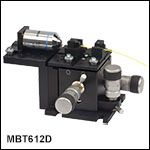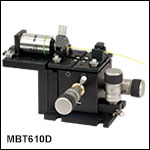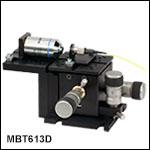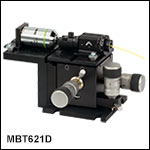Fiber Launch Systems: Basic Solutions

- 4 mm Travel Flexure Microblock MBT Series Stage
- Single Mode and PM Fiber Launch Solutions
- Ideal Lab Starter Kits
MBT610D
Shown with Objective
MBT616D
3-Axis Stage
is Used in Our
Fiber Launch Systems

Please Wait
Features
- Ideal for Ø150 to Ø341 μm Bare Fibers
- Variable Pressure Clamping Arm
- 4 mm Travel Adjustment Range
- Includes 300 μm Fine Adjustment at 50 µm per Revolution
- RMS-Threaded Bracket for Objective Lenses
- Objective Not Included
The MBT612D launch system features our high-resolution differential adjusters that are ideal for optimizing the coupling of a free-space laser into a single mode fiber, even at visible wavelengths where the mode field diameter of the fibers are as small as 3 µm. The addition of a cable strain relief helps to prevent inadvertent disruption of the system, a small feature that can be a great time saver. This preconfigured fiber launch is an ideal starter system that can be quickly adapted to many uses. Additional accessories are available that greatly enhance the flexibility of this platform to perform multiple functions. For details, click here.
| MBT612(/M) | |
|---|---|
| Travel | 4 mm |
| Cross Talk | <20 µm/mm |
| Load Capacity | 2.2 lbs (1 kg) |
| Thermal Stability | 1 µm/°C |
| Weight | 1.65 lbs (750 g) |
| Deck Height | 2.46" (62.5 mm) |
| Optical Axis Height | 2.95" (75 mm) |
| Fiber Diameter Range | 150 µm to 341 µm |
| Differential Adjusters | |
| Coarse Adjustment | 0.5 mm/rev |
| Fine Adjustment (with Vernier) | 50 µm/rev (300 µm Range) |
Choosing the correct lens or objective for launching light into a fiber depends on several factors, such as the input wavelength, beam diameter, and the mode field diameter (MFD) of the fiber. The focal length or effective focal length required to optimize coupling can be estimated using the relationship below. For specific lens and objective recommendations, please contact Technical Support.
As an example calculation, the P1-630A-FC-2 FC/PC single mode patch cable, which incorporates SM600 fiber, has an 1/e2 mode field diameter (MFD) of 4.3 μm at 633 nm. The MFD should equal the diffraction-limited spot size Øspot, which is given by the following equation:

Here, f is the focal length of the lens or effective focal length of an objective, λ is the wavelength of the input light, and D is the 1/e2 diameter of collimated beam incident on the lens.
Lenses or objectives can be used to launch light into an optical fiber. The clear aperture must be larger than the input beam diameter. For optimum coupling, the spot size of the focused beam must be less than the MFD of the single mode fiber. As a result, if a lens or objective is not available that provides an exact match, then choose an optic with a focal length that is shorter than what the calculation above yields. Alternatively, if the clear aperture is large enough, the beam can be expanded before the lens or objective, which effectively reduces the spot size of the focused beam.
| Posted Comments: | |
| No Comments Posted |
Features
- Ideal for Bare, Lensed Fiber, or Sleeved Fibers
- Unique Variable Hexagon Shape Accommodates Cylindrical Objects Ranging from Ø0.125 mm - Ø2.66 mm
- Variable Pressure Clamping Arm
- 4 mm Travel Adjustment Range
- Includes 300 μm Fine Adjustment at 50 µm per Revolution
- RMS-Threaded Bracket for Objective Lenses
- Objective Not Included
The MBT610D launch system features our high-resolution differential adjusters, which are ideal for optimizing the coupling of a free-space laser into a single mode fiber, even in the visible spectrum where the mode field diameter of the fibers are as small as 3 µm. The quick-release fiber holder features a grooved central ferrule with six mounting surfaces, each one designed to accept a different size fiber, from 125 µm to 2.66 mm in Diameter. Simply rotate the ferrule to align the correct mounting groove with the clamping arm.
The addition of a cable strain relief helps to prevent inadvertent disruption of the system, a small feature that can be a great time saver. This preconfigured system is an ideal starter system, which can be quickly adapted to many uses. Additional accessories are available that greatly enhance the flexibility of this platform to perform multiple functions. For details, click here.
| MBT610D(/M) | |
|---|---|
| Travel | 4 mm |
| Cross Talk | <20 µm/mm |
| Load Capacity | 2.2 lbs(1 kg) |
| Thermal Stability | 1 μm/°C |
| Weight | 1.65 lbs (750 g) |
| Deck Height | 2.46" (62.5 mm) |
| Optical Axis Height | 2.95" (75 mm) |
| Fiber Diameter Range | 125 µm to 2.66 mm |
| Differential Adjusters | |
| Coarse Adjustment | 0.5 mm/rev |
| Fine Adjustment (with Vernier) | 50 µm/rev (300 µm Range) |
Choosing the correct lens or objective for launching light into a fiber depends on several factors, such as the input wavelength, beam diameter, and the mode field diameter (MFD) of the fiber. The focal length or effective focal length required to optimize coupling can be estimated using the relationship below. For specific lens and objective recommendations, please contact Technical Support.
As an example calculation, the P1-630A-FC-2 FC/PC single mode patch cable, which incorporates SM600 fiber, has an 1/e2 mode field diameter (MFD) of 4.3 μm at 633 nm. The MFD should equal the diffraction-limited spot size Øspot, which is given by the following equation:

Here, f is the focal length of the lens or effective focal length of an objective, λ is the wavelength of the input light, and D is the 1/e2 diameter of collimated beam incident on the lens.
Lenses or objectives can be used to launch light into an optical fiber. The clear aperture must be larger than the input beam diameter. For optimum coupling, the spot size of the focused beam must be less than the MFD of the single mode fiber. As a result, if a lens or objective is not available that provides an exact match, then choose an optic with a focal length that is shorter than what the calculation above yields. Alternatively, if the clear aperture is large enough, the beam can be expanded before the lens or objective, which effectively reduces the spot size of the focused beam.
| Posted Comments: | |
| No Comments Posted |
Features
- For FC-Connectorized Fiber SMF Patch Cords
- 4 mm 3-Axis Travel Adjustment Range
- Includes 300 μm Fine Adjustment at 50 µm per Revolution
- RMS-Threaded Bracket for Objective Lenses
- Objective Not Included
This system is configured from our MBT616D three-axis flexure stage. When considering a fiber launch system, the use of nested flexure plates in place of more traditional linear bearings provides a number of advantages. First, one obtains nearly perfect smooth continuous motion. Second, the use of a flexure mechanism eliminates the use of lubricants within the stage structure. With traditional bearings, minor imperfections in the bearing or contaminates trapped in the lubricant create localized rough spots where the displacement resolution degrades significantly. The lack of lubricants also minimizes stage creep.
Additional accessories are available that greatly enhance the flexibility of this platform to perform multiple functions. For details, click here.
| MBT613(/M) | |
|---|---|
| Travel | 4 mm |
| Cross Talk | <20 µm/mm |
| Load Capacity | 2.2 lbs (1 kg) |
| Thermal Stability | 1 µm/°C |
| Weight | 1.65 lbs (750 g) |
| Deck Height | 2.46" (62.5 mm) |
| Optical Axis Height | 2.95" (75 mm) |
| Fiber Connector | FC |
| Differential Adjusters | |
| Coarse Adjustment | 0.5 mm/rev |
| Fine Adjustment (with Vernier) | 50 µm/rev (300 µm Range) |
Choosing the correct lens or objective for launching light into a fiber depends on several factors, such as the input wavelength, beam diameter, and the mode field diameter (MFD) of the fiber. The focal length or effective focal length required to optimize coupling can be estimated using the relationship below. For specific lens and objective recommendations, please contact Technical Support.
As an example calculation, the P1-630A-FC-2 FC/PC single mode patch cable, which incorporates SM600 fiber, has an 1/e2 mode field diameter (MFD) of 4.3 μm at 633 nm. The MFD should equal the diffraction-limited spot size Øspot, which is given by the following equation:

Here, f is the focal length of the lens or effective focal length of an objective, λ is the wavelength of the input light, and D is the 1/e2 diameter of collimated beam incident on the lens.
Lenses or objectives can be used to launch light into an optical fiber. The clear aperture must be larger than the input beam diameter. For optimum coupling, the spot size of the focused beam must be less than the MFD of the single mode fiber. As a result, if a lens or objective is not available that provides an exact match, then choose an optic with a focal length that is shorter than what the calculation above yields. Alternatively, if the clear aperture is large enough, the beam can be expanded before the lens or objective, which effectively reduces the spot size of the focused beam.
| Posted Comments: | |
| No Comments Posted |
Features
- Top-Loading Fiber Rotator with Fast-Release Clamp
- 360° Rotation and 2° Accuracy
- 4 mm Travel Adjustment Range
- Includes 300 μm Fine Adjustment at 50 µm per Revolution
- RMS-Threaded Bracket for Objective Lenses
- Objective Not Included
The MBT621D launch system features our high resolution drives that are ideal for coupling a free-space laser into a single mode fiber, even at visible wavelengths, where the mode field diameter of the fibers are as small as 3 µm. The rotary fiber holder provides smooth rotation with negligible run-out. When using polarization maintaining fibers (PM), this system provides an easy means of optimizing the extinction ratio of the signal being coupled through the PM fiber.
Additional accessories are available that greatly enhance the flexibility of this platform to perform multiple functions. For details, click here.
| MBT621(/M) | |
|---|---|
| Travel | 4 mm |
| Cross Talk | <20 µm/mm |
| Load Capacity | 1 kg |
| Thermal Stability | 1 µm/°C |
| Differential Adjusters | |
| Coarse Adjustment | 0.5 mm/rev |
| Fine Adjustment (with Vernier) | 50 µm/rev |
| Rotational Adjuster | |
| Range | 360° |
| Resolution (with Scale) | 5° |
| Fiber Size | Ø125 µm (with Buffer Coating Removed) |
Choosing the correct lens or objective for launching light into a fiber depends on several factors, such as the input wavelength, beam diameter, and the mode field diameter (MFD) of the fiber. The focal length or effective focal length required to optimize coupling can be estimated using the relationship below. For specific lens and objective recommendations, please contact Technical Support.
As an example calculation, the P1-630A-FC-2 FC/PC single mode patch cable, which incorporates SM600 fiber, has an 1/e2 mode field diameter (MFD) of 4.3 μm at 633 nm. The MFD should equal the diffraction-limited spot size Øspot, which is given by the following equation:

Here, f is the focal length of the lens or effective focal length of an objective, λ is the wavelength of the input light, and D is the 1/e2 diameter of collimated beam incident on the lens.
Lenses or objectives can be used to launch light into an optical fiber. The clear aperture must be larger than the input beam diameter. For optimum coupling, the spot size of the focused beam must be less than the MFD of the single mode fiber. As a result, if a lens or objective is not available that provides an exact match, then choose an optic with a focal length that is shorter than what the calculation above yields. Alternatively, if the clear aperture is large enough, the beam can be expanded before the lens or objective, which effectively reduces the spot size of the focused beam.
| Posted Comments: | |
| No Comments Posted |
 Products Home
Products Home
















 Zoom
Zoom


 Basic Fiber Launch Solutions
Basic Fiber Launch Solutions